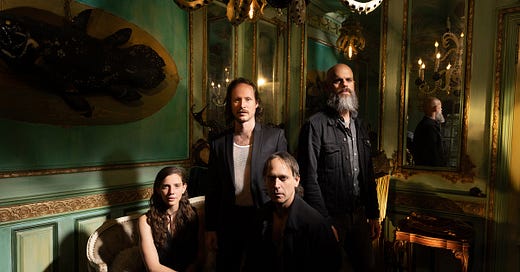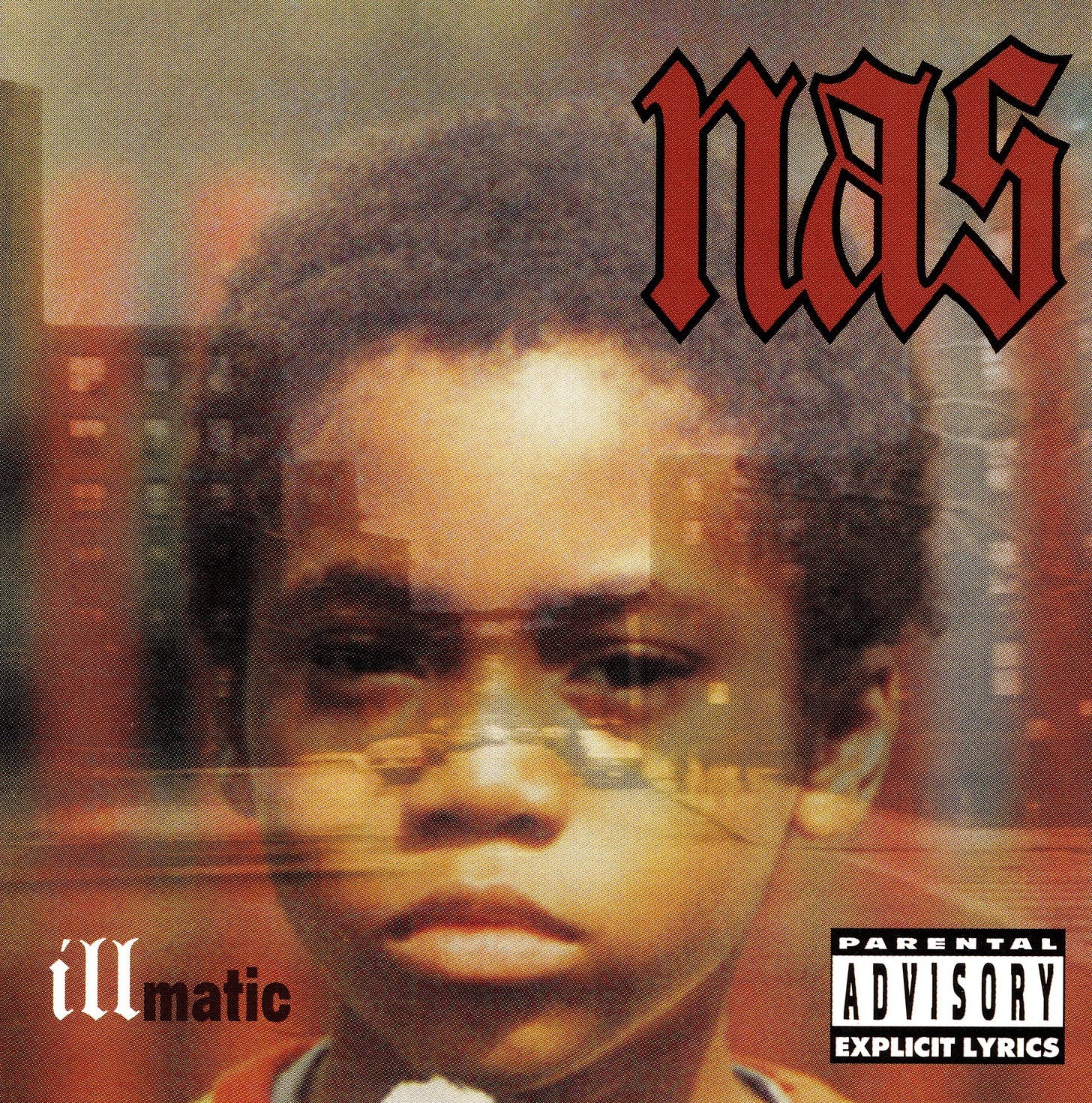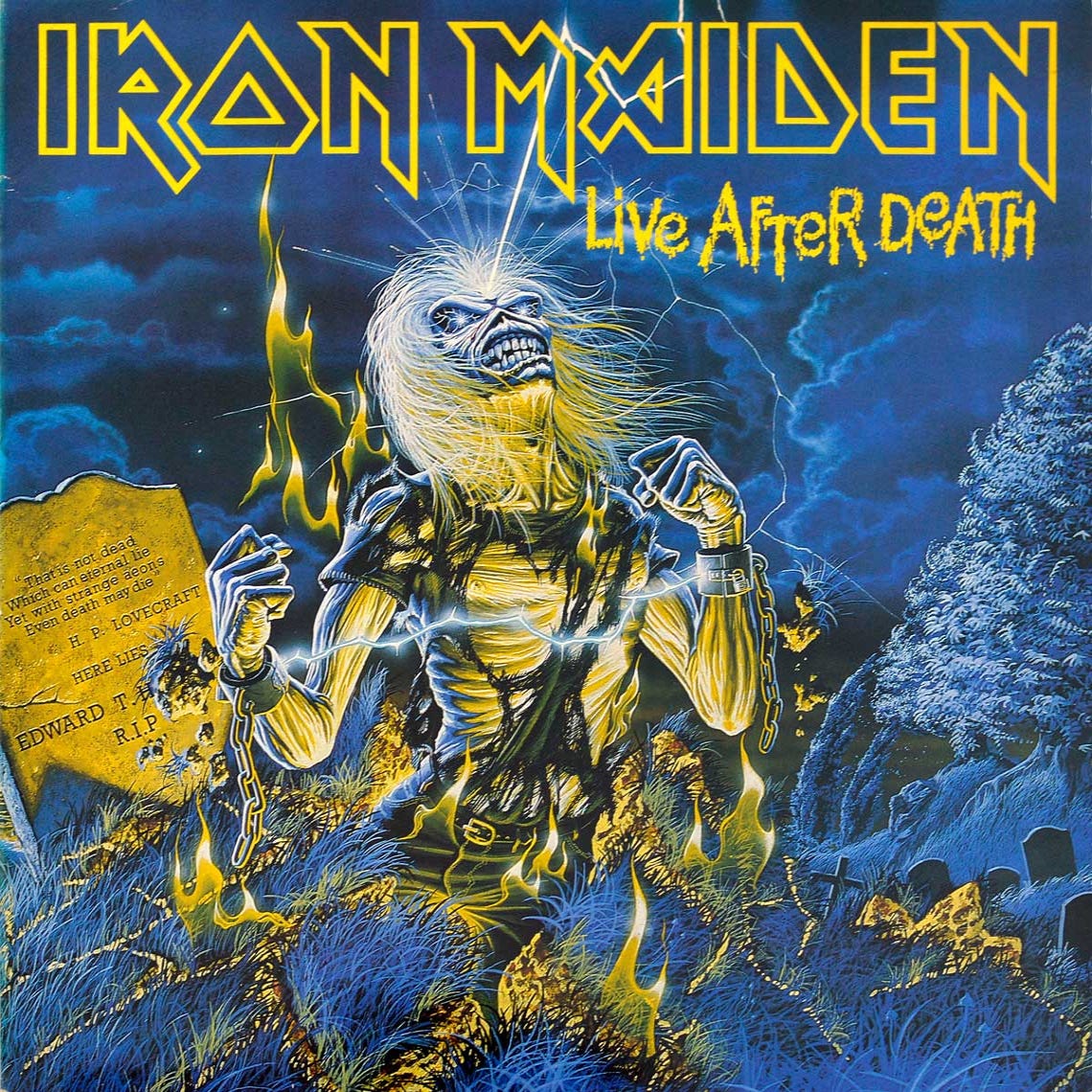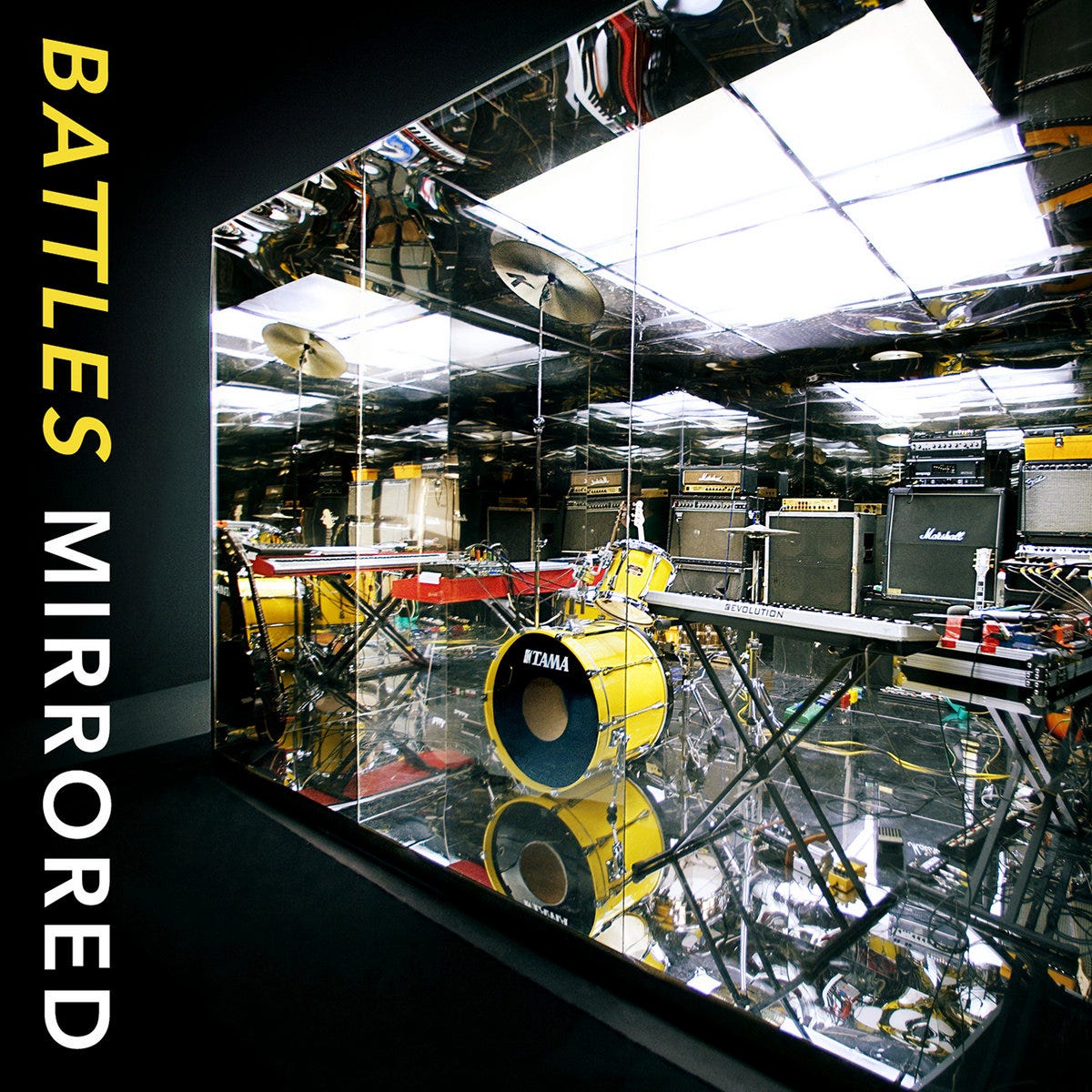Earlier this week my friend and former Lamniformes drummer Peter Reale hooked me up with a ticket to see Baroness perform their Red Album and Blue Record back to back at Sleeping Village. I’m so out of the loop these days, nose to the grindstone and all that, that I had no idea this double feature was even coming to Chicago. Had I been better forewarned I would have snapped up tickets myself. All’s well that ends well, though. After dinner on Wednesday night I ferried up from Humboldt Park to Avondale to see two old favorites from my college years performed in full.
It does not take much convincing for me to see Baroness live if the opportunity arises. Ever since I saw them at the Metro in 2016 I’ve told anyone who cared to ask that they were one of the best live bands in heavy metal. They have a world class rhythm section (Sebastian Thomson drums in Trans Am, and bassist Nick Jost moonlights in the jazz rock freakout act Horse Torso) and an equally world class guitar duo willing to ham it down stage like it’s 1985. Singer & guitarist John Baizley, an intimidating presence on stage all by himself, isn’t shy about demanding energy from his audience, punctuating each song by flinging his arms skyward and grinning straight into the back rows. He also knows how to write a chorus that the similarly large dudes in the audience can easily bellow back at him. Songs I never particularly loved on their later records feel like bona fide anthems in Baizley and company’s hands. Now you’re telling me *that* band is playing exclusively material from my two favorite Baroness albums? You won’t have to tell me twice.
By the time I started seeing Baroness live they were no longer strictly the same band that recorded Red and Blue. Following a major car accident on tour in 2013 the original rhythm section declined to rejoin the band. Now in 2025 Baizley is the only original member, joined by Thomson, Jost, and guitarist Gina Gleason. As excited as I was to see Baroness 2.0 take on the original’s best work, I was equally curious about what it must be like for them to inhabit music written different group of people in a different stage of life. Though they were already leaning to the center on 2012’s double album Yellow & Green, the post-crash Baroness went all in on hooks and melody, writing the kind of choruses that earn you nods from the Grammy Awards. By comparison Red & Blue are the product of instrumentalists first and songwriters second. I’ve always suspected that facing the specter of death made Baizley reorganize his priorities. One only needs recall Metallica in the wake of Cliff Burton’s death on the road for historical precedent. But despite their best efforts Baroness never cracked into the true mainstream the way The Black Album did.
Baroness are a band haunted by “what could have been” twice over. What could have been had the van not crashed and the original lineup, the one that wrote Red & Blue, soldiered on. Where would they have taken their sound without that traumatic interruption? Then on the other side there’s the sense that this current version of Baroness never quite reached the potential heights suggested by their lean into arena rock. Shouldn’t this band have been huge? They were the chosen ones of Brewer Metal. Mastodon were already a big deal and here comes a band from the same part of the country with actual choruses and a singer with legit sex appeal. Then you blink and years pass and Baroness are home recording their new material and under-playing at a venue well below their cap to a room of aging die-hards.
Not that I’m complaining mind you. Sleeping Village is a great place to see a band like Baroness. The sound is excellent. The stage is easy to see from many angles. And perhaps most importantly for a Brewer Metal show, they’ve got an intimidating beer list. Sleeping Village’s rotation included both a “Cushy Blue” sour and a “Red Seal” lager. I drank the Cushy Blue during the opener’s set and thought it tasted like a Naked juice that had dropped out of high school. I saved the Red Seal for Baroness’s Red set and thought it tasted like a beer, idk. My friend and Ferrn bandmate Jonathan Mondragon pointed out that I could have just had a Pabst Blue Ribbon instead of throwing down for a fancy sour, but where’s the fun in that? Baroness went so far as to light each set in strict monotone according to the title, with inverse results to my choice of drinks. Red stage lighting for 40 minutes straight is tough on the eyes and leaves the whole room feeling hot and musty. After a breath of fresh air and the switch to cooler tones on stage, the Blue album couldn’t help but feel like an improvement.
Watching Baroness play Red and Blue back to back did funny things to my sense of time. On the one hand buying into the premise that Baroness could play nothing they’d written since Jackass 3D was in theaters encouraged me to role-play an audience member in the late 00s. What would it have been like to hear this music in small club in Georgia where the band got their start, or at their first New York gigs where they won over the metal media? In this respect the red lighting was immersive, simulating Savannah’s all encompassing humidity. Red is a *sweaty* album, a product of long hours practicing in windowless basements. It is a drenched t-shirt with the sleeves cut off in order to make work easier and to demonstrate that a lot of work has been done already. This is music designed to win over complete strangers through force of will. Everything that could be drilled down has been drilled down. Every acceleration in tempo, every new twist in the intertwined guitar lines and each shift in the rhythm section behind them expresses a single-minded need to not let the crowd lose interest for a second. It is exhilarating at its best, but also exhausting to perform as I’ll get into shortly.
I have never spent more than 36 consecutive hours in the state of Georgia so I’m no expert, but Red has always felt distinctly *southern* to me. You can hear the twang in both the vocal harmonies and the finger picked acoustic interludes, both gamely handled live by Gina Gleason, who also unleashed ‘80s shredder havoc on the instrumental “Teeth of a Cogwheel”. You can hear it in the twin leads too, in the way they harmonize with the Thin Lizzy worship happening in the garage rock scene only a stone’s throw away in Tennessee at the end of the 00s. Hearing Red in full I flashed back to the one full day I spent in Savannah back in 2015. I thought of drooping vines and thick heat. I thought about my friend Ryan McCardle.
The other way that hearing Blue Record live only 5 minutes removed from the end of Red Album distorts time is that it condenses two years into the time it takes to tune a guitar. The Baroness that recorded Blue had seen more, done more, expanded the horizons of their music beyond the limits of their practice room and onto the world’s (underground) stage. The songs don’t expend as much energy trying to impress their audience, instead they proceed with their rapt attention as a given. The biggest change comes from the bass and drums, who by this point have learned to support the star power of the guitar tandem instead of trying to steal the spotlight from them. The songs on Blue are bouncier, once they find a groove they stick to it. It’s energy well saved. “Isak” from Red might be the enduring fan favorite, but Blue’s “A Horse Called Golgotha” was easily the night’s best number. It’s the kind of song that compels me to raise my voice up to the 5th for every call and response chorus, even when I don’t know any of the lyrics.
After this show I wish I’d studied Baroness’ lyric sheets a little more dutifully. Only a few songs into Red it was clear that Baizley’s voice was not holding up. I can’t say I’m surprised. This was the second night in a row of singing 90 minutes of music written and recorded by a younger man with less to lose. The notes are higher and the growls lower and more frequent than on later Baroness albums. Like a true pro, Baizley tried to gut it out anyway. Between songs he apologized for his rough state and eventually asked the crowd to help sing the lines that he couldn’t. This broke my heart in the small way that seeing any band you loved a child does when you see them as an adult. For everything that Red and Blue are, they are not albums that inspire you to memorize words. Outside of a few shouts along with the first few songs of Red, the crowd hardly took up the challenge. The irony was that the songs that were putting Baizley’s voice under such strain were written before he learned how to pen a chorus that could inspire a crowd to take the lead for him. Luckily those same songs gave him plenty of time to lean on the rest of his band, along with his own prodigious guitar skills, instead. They did more than their share to prop him up.
# # # # # The Promo Zone # # # # #
The first ever Ferrn live show is swiftly approaching! If you live in Chicago or the nearby area come to The Burlington on June 3rd to see us play material from the band’s debut Endless & Elsewhere alongside brand new material written since I joined. Last weekend Ryan I got together to load up my Roland SPD sampler with some cool digital sounds that I can play alongside We go on last, so stock up on energy. See you there!
Thank you for reading this free issue of Lamniformes Cuneiform. If one email full of musical recommendations and insights into music culture does not satisfy your hunger for tunes, consider subscribing for $5 a month or go all in for $40 a year. Paying subscribers get access to exclusive annotated playlists, behind the scenes access to my own music, and other illusive perks. Jump in, the sharks won’t bite!
🦈 🦈 🦈 🦈 🦈 🦈 🦈 🦈 🦈 🦈 🦈 🦈 🦈 🦈 🦈 🦈 🦈 🦈 🦈
~ ~ ~ ~ ~ Listening Diary ~ ~ ~ ~ ~
Listen to this year’s running diary on Apple Music.
“Fact 2” by Poison Girl Friend (Melting Moment, 1992)
Shout out to the Pitchfork Sunday series for introducing me to this track. Those Sunday reviews remain the best thing on the site. I love the dance between the two different snare drums on this track. I wonder whether the sounds of digital phones dialing and ringing were annoying for contemporary audiences, to me they sound pleasantly nostalgic for the early days of dial-up modems and PS1 menu music.
“I Can Do What I Want” by Mei Semones (Animaru, 2025)
Though they’re hardly similar at the level of affect, Mei Semones’ fusion of MPB, jazz rock and the vaguest hint of prog reminds me more than a little of Geordie Greep’s excellent The New Sound from last year. If the Greepster was too quirked up for you, Semones’ softer more indie-friendly style might do the trick instead. I love that this song’s complicated arrangement only serves to underline the lyric. This Berklee grad isn’t going to dumb it down for anyone.
“La Verdad” by Héctor Lavoe (Comedia, 1978)
I feel like you can hear the exact moment the coke hits the band’s bloodstream at 3:35. Salsa spring remains undefeated.
“Djan Djan” by Angélique Kidjo (Ayé, 1994)
Among the most valuable skills for a drummer in 2025 is a bone deep familiarity with the 2 against 3 polyrhythm. It’s essential to be able to hear both “sides” of the rhythm, to count a phrase in both simple time (groups of two) and compound time (groups of three). This song is great ear training practice, if you follow the bass line you get a bouncy triplet rhythm, but if you follow the vocals or drums it’s a slow four count instead.
“Corinthians” by billy woods (Golliwog, 2025)
Golliwog’s my favorite billy woods solo record in a while and an early lock for my end of the year lists. Obviously woods himself is the star, but I cracked a big smile when I heard Despot’s voice on this track. I’ve long given up hope that the mythical Despot album will arrive, but I remain grateful for every verse we get from the guy.
\ \ \ \ \ Micro Reviews / / / / /
Here are five micro reviews of albums from my vast Rate Your Music catalog. Long time Lamniformes Instagram followers will recognize these from my stories, however they’ve been re-edited and spruced up with links so that you can actually hear the music instead of just taking my word for it.
Dopesmoker by Sleep (2003) - Doom Metal
A legendarily shelved single track album written in honor of loud amplifiers and louder weed, Dopesmoker accrued a cult reputation among metal heads and discerning music nerds alike long before it eventually made its way into record stores. For years I only knew it as a “get a load of this” urban legend among filesharers. Does it live up to the rep that precedes it? As both a historical oddity and a collection of music, the answer is unequivocally yes. Despite being about as much metal as you can physically fit on a disc, it’s not too surprising that this record has a sizable crossover audience. The sonic density and meditative repetition render the riffs into more of a sound bath than a song. Plus, the drumming barely resembles heavy metal at all. Just try to keep track of where the snare is going to land measure to measure, I dare ya. The loose, rambling percussion only heightens the album’s strangeness. A must listen for any self-described ‘head.
Illmatic by Nas (1994) - Rap
As a rap neophyte Nas’s debut album was presented to me by older fans, music media, and music academia as the pinnacle of New York rap’s golden age and a dividing point in the genre’s history and technical development as a whole. There’s rap before Nas and after him. While the quality of the record justifies its reputation, designating it as the greatest of all time feels a little like picking Mario in Mario Kart. What I mean is that all the sliders are exactly in the center. Illmatic is uncomplicatedly a rap album about rapping. There’s no fluff, no radio-oriented hooks, practically no guests or skits, not too street, not too conscious, nothing but rhymes and beats for 40 minutes. That makes it an accessible record and an easy one to get a feel for, but also leaves it a little dry, maybe even humorless? The most telling line is “life is parallel to hell but I must maintain”. The early Nas persona is all stoic endurance and even-keeled composure blunted by a stoner’s introversion. The verses are so involved and so well performed that he doesn’t come across as aloof. Instead, shocking considering his age, he sounds like a beleaguered veteran of the world he’s describing.
One of my all time favorite records to play drums along with, just one terrific beat after another.
Abbey Road by The Beatles (1969) - Rock
Though I’m no Beatle-maniac I’ve always had a soft spot for the Fab Four’s final-ish full length. Abbey Road is the prog fans’ Beatles record of choice, due in large part to the continuous medley that takes up the second side of the album. Side A on the other hand is the sound of a band pulling itself in every direction but together. Paul sings his throwback love songs, John nearly invents heavy metal (“Helter Skelter” has nothing on the riff from “She’s So Heavy”), George comes off the bench with an all time great pop song, and Ringo, well, he’s too benign to complain about. The tension between these different personalities is what makes this record so interesting to me, even after years of over-exposure to the songs in music education.
Live After Death by Iron Maiden (1985) - Heavy Metal
For a band who release roughly one live album per tour, this is the only Iron Maiden live album you truly need. Recorded at the height of their powers, this collection features tracks from their debut through 1984’s Powerslave. Are the live versions substantially different than the studio recordings? For the most part no, though the minor differences add up. First, the mix makes it way easier to distinguish the two guitar lines, which makes these songs *even more* melodic. Second, it’s a blast to hear Nicko McBrain tear through the songs recorded before he joined the band. And finally Bruce Dickinson is an absolute nut, inserting a Hetfield-ian number of “YEAH”’s into every song along with some iconic banter. A thrilling essential for any true blue Maiden fanatic.
Mirrored by Battles (2007) - Prog Rock
An album that should come with a “don’t try this at home” sticker if only to encourage those brave enough to ignore the warning. Battles are a best case scenario for a rock band taking up the challenge of electronic dance music, and an example of the kind of hijinks you can get away with only if John Stainer is drumming for you. On Mirrored they put their overflowing technical skills to the task of grooving hard and bending the limits of their instruments harder. Though they aren’t “songs” in the traditional sense these tracks argue that rhythms and textures themselves can be hooks. While I enjoyed this album when it came out I’ve learned to appreciate it even more these days. Though it occasionally suffers from the ice-cream-truck-ification endemic to pedal-centric rock, this is a certified classic from a bygone era when indie bands could shred and shredders could party.










I love that Iron Maiden album. It was actually my first one from them and I was instantly hooked.